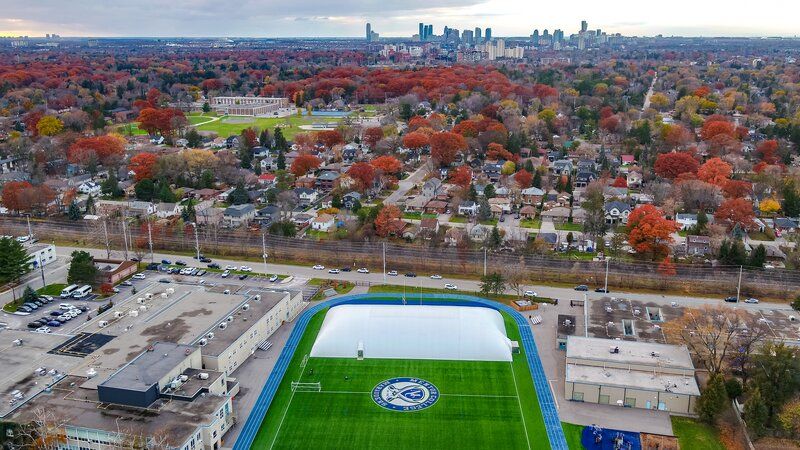
We collect basic website visitor information on this website and store it in cookies. We also utilize Google Analytics to track page view information to assist us in improving our website.

As the weather turns colder and the days shorter, sports lovers grapple with unpredictable weather conditions. The transition from fall to winter can be challenging, not just for athletes and coaches, but also for facility owners, as it impacts the continuity of all kinds of outdoor sports: soccer, tennis, golf, track and field, and other field sports.
However, there's a practical solution to this dilemma: air-supported domes. These domes are a game-changer for seasonal sports. They extend the momentum of summer activities into the fall and seamlessly carry it through the winter's chill.
Under a Farley Dome, athletes can train and compete in comfortable, consistent conditions, regardless of the weather outside. Essentially, domes bridge the gap between fall and winter sports, turning a once challenging period into a seamless, year-round sports experience.
In this blog post, we will talk about the many ways that air-supported domes not only benefit facility operators but also athletes and the broader sports community during the fall-to-winter transition.
The Farley Group has been manufacturing, installing, and servicing sports domes around the world for more than 50 years. Ever since our founder, Ralph Farley, introduced air-supported domes to North America, The Farley Group has led the industry with our commitment to quality and integrity. Our team consists of sales consultants, designers, and highly skilled production and service professionals skilled in all aspects of air structure technology. We’d love to talk to you about your dome project.
Call us or send us a message to get started now!
In Canada and the States, where the weather shifts from mild to harsh unpredictably, transitioning between seasons poses a significant challenge for sports continuity. Sports popular in the summer months often come to a halt in the winter, especially in communities lacking affordable indoor sports facilities.
Warm-weather sports like soccer, tennis, and golf really feel the impact when seasons change. Air-supported domes, however, make transitioning from fall to winter in these sports effortlessly smooth.
The excitement of a soccer game on a crisp fall day can quickly diminish with unpredictable weather. Rain, snow, and cold not only dampen spirits but also disrupt schedules, rendering fields unusable and hazardous. What were once lush, green fields become muddy or icy, increasing injury risks and diminishing the quality of play.
Plus, shorter days limit practice and game time, forcing players and coaches to squeeze in activities before nightfall.
Example: Afrim's Sports is the place to be when it comes to indoor soccer in the Albany, New York area! Located at the home of the Bethlehem Soccer Club, this Farley Dome covers nearly 44,000 square feet of indoor turf.
Tennis courts also suffer from seasonal changes. Damage from moisture, cold, and freeze-thaw cycles compromises playing surfaces, making them unsafe and hindering the play experience.
Cold temperatures also affect players and their equipment, with every drop in temperature impacting comfort and performance.
Without indoor alternatives, players lose valuable practice time essential for skill development and competitive edge.
Example: Barrie North Winter Tennis, a division of Tennis Clubs of Canada, is located in Midhurst, Ontario, and consists of 4 tennis courts under a heated, air-supported Farley dome complete with new LED lighting. The Farley Dome is erected in early October, and is taken down at the end of April each year.
Golfers face challenges as driving ranges become less inviting in colder, wetter conditions.
Practicing swings and techniques is harder, and golf gear, like balls, performs differently in the cold, affecting gameplay. This drop in comfort and accessibility leads to reduced player turnout.
Example: The Hastings Fieldhouse Farley Dome features a walking track, soccer field, golf driving range, as well as courts for basketball, ball hockey, and racquet sports. It truly is a multi-functional facility. It includes the capacity to accommodate many varied and unique training activities, as well as clinics and workshops.
Winter poses major challenges for track and field athletes. Outdoor tracks, essential for training, become unusable due to snow and ice. Each event, with its specific training requirements, is disrupted, affecting preparation and performance.
The cold weather also increases the risk of muscle strains and injuries, as proper warm-up becomes more difficult and slippery conditions pose additional hazards.
Example: The Farley Dome at University of Alberta's Foote Field is the largest, air-supported dome structure in all of Alberta, turning the seasonal field into a year-long training facility. It includes a multi-lane, 140 meter track with a jump pit available to the track and field community of Edmonton.
Each year, facility owners and operators face the challenging transition from fall to winter sports. This is where air-supported domes, particularly Farley Domes, come into play. Our domes are designed to help make manging sports facilities straightforward and efficient, regardless of the season.
One of the standout features of our domes is their rapid setup. They can be erected in just a day or two, minimizing downtime and keeping the sports schedule on track. This speed is a lifesaver for places that need to switch from open-air to indoor settings quickly when the weather changes.
Timing is everything here. Facility owners can time the dome set-up right at the end of the fall season. This means no awkward gaps — just smooth sailing from outdoor to indoor sports. It's this kind of scheduling smarts that helps get the most out of facilities all year round.
The ability to control the climate inside these domes is a significant advantage. Owners can dial in the perfect temperature, making it comfy for both players and fans. This matters a lot when you're moving from the mild fall to the chilly winter.
Stable conditions are key for sports where the weather really affects the game. Domes keep things consistent, offering the best setting for sports, come rain or shine.
Energy efficiency is another big plus. These domes use smart heating and cooling, keeping costs down, especially in the colder months when heating bills can go through the roof.
Domes are champs at handling sudden weather shifts. They can warm up or cool down in no time, crucial for dealing with those unpredictable fall and early winter days. This means the facility stays open and comfy, no matter what Mother Nature throws at it.
These domes also extend playtime. As days get shorter and colder, indoor domes offer a bright, warm spot for evening and night games.
And let's not forget how well they protect against the elements. Wind, rain, snow — domes keep them all out. This means less weather delays and more reliable schedules for teams and facility owners.
With their quick setup, climate control, and weather readiness, they're the perfect choice for facility owners wanting to keep the game going all year long. Choosing a dome isn't just prepping for winter; it's opting for non-stop sports, no matter the season.
For sports facility managers wrestling with tough decisions, choosing air-supported domes is a no-brainer. It's a move toward keeping the action going and growing. Think of it as an investment that pays off in more ways than one!
Why let the weather dictate another season? Now's the chance to turn your sports facility into a year-round hub of excitement.
